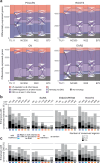MaizeCODE reveals bi-directionally expressed enhancers that harbor molecular signatures of maize domestication
- PMID: 39738013
- PMCID: PMC11685423
- DOI: 10.1038/s41467-024-55195-w
MaizeCODE reveals bi-directionally expressed enhancers that harbor molecular signatures of maize domestication
Erratum in
-
Author Correction: MaizeCODE reveals bi-directionally expressed enhancers that harbor molecular signatures of maize domestication.Nat Commun. 2025 Jul 23;16(1):6790. doi: 10.1038/s41467-025-62179-x. Nat Commun. 2025. PMID: 40702017 Free PMC article. No abstract available.
Abstract
Modern maize (Zea mays ssp. mays) was domesticated from Teosinte parviglumis (Zea mays ssp. parviglumis), with subsequent introgressions from Teosinte mexicana (Zea mays ssp. mexicana), yielding increased kernel row number, loss of the hard fruit case and dissociation from the cob upon maturity, as well as fewer tillers. Molecular approaches have identified transcription factors controlling these traits, yet revealed that a complex regulatory network is at play. MaizeCODE deploys ENCODE strategies to catalog regulatory regions in the maize genome, generating histone modification and transcription factor ChIP-seq in parallel with transcriptomics datasets in 5 tissues of 3 inbred lines which span the phenotypic diversity of maize, as well as the teosinte inbred TIL11. Transcriptomic analysis reveals that pollen grains share features with endosperm, and express dozens of "proto-miRNAs" potential vestiges of gene drive and hybrid incompatibility. Integrated analysis with chromatin modifications results in the identification of a comprehensive set of regulatory regions in each tissue of each inbred, and notably of distal enhancers expressing non-coding enhancer RNAs bi-directionally, reminiscent of "super enhancers" in animal genomes. Furthermore, the morphological traits selected during domestication are recapitulated, both in gene expression and within regulatory regions containing enhancer RNAs, while highlighting the conflict between enhancer activity and silencing of the neighboring transposable elements.
© 2024. The Author(s).
Conflict of interest statement
Competing interests: The authors declare no competing interests.
Figures







Similar articles
-
Teosinte Pollen Drive guides maize diversification and domestication by RNAi.Nature. 2024 Sep;633(8029):380-388. doi: 10.1038/s41586-024-07788-0. Epub 2024 Aug 7. Nature. 2024. PMID: 39112710 Free PMC article.
-
Molecular evolution of a reproductive barrier in maize and related species.Genetics. 2025 Jul 9;230(3):iyaf085. doi: 10.1093/genetics/iyaf085. Genetics. 2025. PMID: 40335053 Free PMC article.
-
An ancient origin of the naked grains of maize.Proc Natl Acad Sci U S A. 2025 Jun 24;122(25):e2503748122. doi: 10.1073/pnas.2503748122. Epub 2025 Jun 17. Proc Natl Acad Sci U S A. 2025. PMID: 40526715
-
The Black Book of Psychotropic Dosing and Monitoring.Psychopharmacol Bull. 2024 Jul 8;54(3):8-59. Psychopharmacol Bull. 2024. PMID: 38993656 Free PMC article. Review.
-
New Approaches to Assess Mechanisms of Action of Selective Vitamin D Analogues.Int J Mol Sci. 2021 Nov 16;22(22):12352. doi: 10.3390/ijms222212352. Int J Mol Sci. 2021. PMID: 34830234 Free PMC article. Review.
Cited by
-
Constraint of accessible chromatins maps regulatory loci involved in maize speciation and domestication.Nat Commun. 2025 Mar 12;16(1):2477. doi: 10.1038/s41467-025-57932-1. Nat Commun. 2025. PMID: 40075057 Free PMC article.
-
Duckweed genomes and epigenomes underlie triploid hybridization and clonal reproduction.Curr Biol. 2025 Apr 21;35(8):1828-1847.e9. doi: 10.1016/j.cub.2025.03.013. Epub 2025 Apr 1. Curr Biol. 2025. PMID: 40174586 Free PMC article.
-
Decoding complexity: tackling the challenge of how many transcription factors regulate a plant gene.Transcription. 2025 Apr-Jun;16(2-3):261-283. doi: 10.1080/21541264.2025.2521767. Epub 2025 Jun 25. Transcription. 2025. PMID: 40566792 Free PMC article. Review.
-
Transcription factor binding site divergence across maize inbred lines drives transcriptional and phenotypic variation.bioRxiv [Preprint]. 2024 Jun 3:2024.05.31.596834. doi: 10.1101/2024.05.31.596834. bioRxiv. 2024. Update in: Nat Plants. 2025 Jun;11(6):1205-1219. doi: 10.1038/s41477-025-02007-8. PMID: 38895211 Free PMC article. Updated. Preprint.
-
Transcription factor binding divergence drives transcriptional and phenotypic variation in maize.Nat Plants. 2025 Jun;11(6):1205-1219. doi: 10.1038/s41477-025-02007-8. Epub 2025 Jun 12. Nat Plants. 2025. PMID: 40506505
References
-
- Stitzer, M. C. & Ross-Ibarra, J. Maize domestication and gene interaction. N. Phytol.220, 395–408 (2018). - PubMed
-
- Wang, B. et al. Genome-wide selection and genetic improvement during modern maize breeding. Nat. Genet.52, 565–571 (2020). - PubMed
-
- Chen, L. et al. Genome sequencing reveals evidence of adaptive variation in the genus Zea. Nat. Genet.54, 1736–1745 (2022). - PubMed
Publication types
MeSH terms
Substances
Associated data
- Actions
- Actions
- Actions
Grants and funding
LinkOut - more resources
Full Text Sources
Molecular Biology Databases

